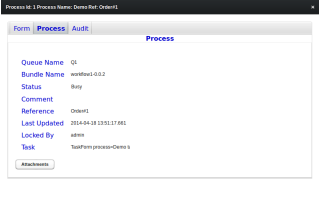Here’s what I have been working on recently: Madura Workflow.
At this point your eyes glaze over, of course, but let me assure you that this stuff is really neat, even though you almost certainly don’t need it.
Over the decades I’ve come across quite a few Workflow products, sometimes they’re called Business Process Engines and such like. There may be a problem with specific definitions I’ve never got to the bottom of, anyway I was never happy with them. So here’s my effort.
You use workflow when you’re building the kind of computer application that needs multiple tasks done by different users, some of them external users, at different times, possibly over weeks or months. Maybe you need to handle a complex insurance application which needs several actuaries to look at different aspects of it, you might want to send parts of it out to external consultants and get a response back, some of those might be automated. The application’s route through your system might need decisions made which influence its path. For example if some amount is larger than a cutoff point the application may have to go to a supervisor who is authorised to handle it rather than the lowly minion it would go to by default. It might need to send a credit check request off to the credit reference agency who have an automated response system, and they charge for each request so you want to avoid sending to them if you don’t need to. Choices again.
The process definition works through the steps, but under that there are tightly integrated rules provided by my Madura Rules Engine. This means that you don’t have to write code to make it all work. The rules fire automatically (tightly integrated, see?) and stuff just happens. This ensures the process definition is not polluted by a load of non-relevant logic. In other products like this they often are polluted, you see, and it means business rules are spread all over the place in the system, making it hard to find what you have to change. There are validation rules, process rules, UI handling rules and so on. In this they are all in Madura Rules.
We can send Web Service messages out to external services and process the responses. Again this is done with no code. We use Spring Integration to handle this at the moment, though the connection point to that is very thin and it could be replaced by something similar. Anyway, it means that, unlike many workflow systems, the process definition is not polluted by details of the messaging.
When you have a task that needs user interaction you can present a form generated from the data structure (again no code required) for the user to complete. Naturally the form is connected to an object that is monitored by Madura Rules. So you get all the validation and error handling etc you could want. You can, if you want something more specific, write some Java+Vaadin code for a specific form.
You’ll gather by now that implementing a process is pretty simple because it is detached from the generally nasty business of defining application logic, UI code and messaging. That’s the idea but there’s another trick here too. In practice these kinds of coordinated processes can take weeks or months to pass through a business system. They might even get passed back and forth between two or more people several times. What happens during that time if you want to change the process definition, or the rules, or the form or the messages?
Obviously I wouldn’t raise the issue unless I had good news. Madura Bundle allows us to package all of that stuff into a separate bundle file that is hot-swappable without having to restart the server(s). Existing process instances remember what bundle they started with and they keep using that. Newly launched processes use the latest bundle. Easy. So, for example, if that cut-off point mentioned above needed to change you could just regenerate the bundle with a new value.
If you’ve read this far you might want to take a look at the rest of madura. All this stuff is open source and, except for commercial implementations of the rules engine, entirely free.
There’s a UI which is fairly complete based on Vaadin, but the underlying workflow library is agnostic to the UI technology, so if you prefer something else go for it. I already said the messaging platform, Spring Integration, can be switched for something else and actually even Madura Rules could be replaced because it is implemented as a plugin to Madura Objects and you could replace it with another plugin.
 Madura Software
Madura Software
